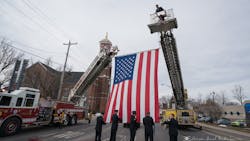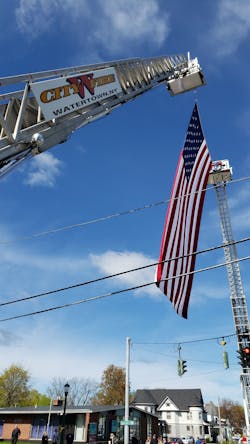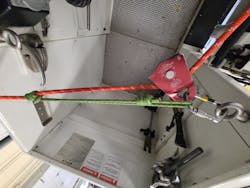As firefighters, every now and then it is necessary to display our nation’s flag at a parade, funeral or other event. Although there are many ways to properly display an American flag, none is more majestic than proudly flown between two aerial ladders high above a street or roadway. It is a visual display of pride that will be seen by many and remembered by everyone. Although a seemingly simple task, it’s an operation that involves careful planning and preparation. Setting up a flag display is a low-risk activity but also is low-frequency, and there will be obstacles that you must overcome.
The logistics
Begin by identifying the particulars, such as where and when the display will take place, who is the point of contact and what is the purpose of the event?
If the display is for a funeral, meet with the funeral director and find out the schedule and route of travel. Funeral directors are an excellent resource, because they are experts at planning and preparing for sensitive events. Odds are that you will find them to be more than helpful and willing to assist you to make sure that things go smoothly.
If the display is for a parade, contact the person who is in charge to find out where he/she would like the flag located. Sometimes the initial placement isn’t conducive to aerial operations, so the site might need to be reconsidered: Every apparatus is different when it comes to size and footprint.
If possible, scout the area where the display will occur to preplan your apparatus placement. Look for any hazards that might be a factor, such as trees, curbs, manhole covers or overhead power lines. This might be a factor when setting up two aerials on a narrow street.
Once the area has been approved, have police or public works block off the area where the apparatus will park. If multiple companies or departments are participating, speak with the company officer or chief to set up a plan. Once the display is set, your company will be out of service for the duration of the event, so act accordingly. Don’t wait until the last minute. Give yourself enough time to prepare.
It always is a good idea to check the weather the day before the event, too. Foul weather, such as rain and lightning, will be something to consider as well as high winds, which can wreak havoc on a large flag.
Flag details
Once the location is selected, determine the flag to be displayed. American flags are available in many different sizes and material. Inspect the flag beforehand, particularly if you will be borrowing one. Take note of any rips or tears and check for cleanliness. Laundering a large flag can be challenging. Some dry cleaners offer this service free for American flags. Talk to your local dry cleaner to find out whether this is a service that it offers.
What are the connections on the flag? Are they at the top and bottom? Some flags have brass grommets; others have metal thimbles. They can be on the top, bottom and along the sides or a mix of both.
Some flags have vent holes to allow air to pass through, which reduces the effects of wind. The flag should be allowed to fly freely unless absolutely necessary to avoid obstacles.
If you determine that it would be safer to secure the flag on both the top and bottom because of trees or powerlines, remember, you essentially are creating a sail, and the effects of wind shouldn’t be underestimated.
All of these factors will affect how the flag is raised and rigged to the apparatus.
Rigging the flag
Rigging the flag to the aerial is a fairly simple process but requires careful coordination and communication. When using large flags, the weight of the flag itself combined with the effects of even minor wind can make controlling the flag by hand difficult. The best way to secure the flag is with a simple rope system. The possibilities are endless but try to keep it simple. The most important part of the system is progress capture. There are many devices that will accomplish this. The simplest is a utility rope that has a Prusik and a pulley. This works well for allowing the flag to be raised and secured while still allowing for minor adjustments.
Make sure that you have enough rope to reach the ground. Whether you are using a platform or ladder will determine how the system will be tied into the aerial. Platforms have anchor points, which are more than sufficient and work well. Ladders might require a piece of webbing around a rung or rail for an anchor.
The flag can be deployed either from ground level or from the bucket of the truck. Depending on the location, either might be appropriate. Place a spotter on the ground to coordinate the position of the flag. Communicate via radio with all of the personnel who are involved to raise the flag and position its alignment. According to the United States Flag Code, the union should be to the north in an east and west street and to the east in a north and south street.
Once the flag is raised secure, it in place and monitor it for any changes. Someone should be detailed to make any necessary adjustments during the display, such as loose lines or entanglements.
Lowering the flag is the reverse process. While maintaining constant communication, lower the flag in a controlled manner. Have enough personnel to make sure the flag doesn’t touch the ground.
Launder the flag if necessary and store it in the appropriate manner. As always, follow the federal flag code regarding flag etiquette.
Flying a flag from a fire apparatus is a visual display of pride and honor for your department and for our country. The American flag is a symbol of freedom and of our nation. It is important that we display it with honor and respect.
About the Author
Andrew Naklick
Andrew Naklick has been a firefighter since 2003. He currently serves as a captain with the City of Watertown, NY, Fire Department, assigned to the ladder company. Naklick is a member of the department’s fire investigation team and swift-water rescue team and formerly served as the department’s community risk reduction officer. He is an adjunct instructor in the fire protection technology program at a local community college and holds an associate degree in fire science. Naklick currently is a student in the National Fire Academy’s Managing Officer Program.


